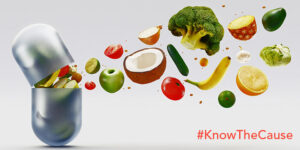

Mycotoxins frequently contaminate grains and grain products used for animal feeds and human foods. On a global level- between 30 and 100% of all grain based feed and food samples are contaminated with measurable levels of mycotoxins.
Domestic animals such as cattle, pigs, chickens, and turkeys typically consume feeds which are about 50% grains. Mycotoxins consumed by animals can be absorbed by humans who eat meat, milk, and eggs from animals who eat contaminated feeds.
Mycotoxins are often found in bakery goods like bread and cake and in processed foods like soups and meat products which contain grain products and/or meat from animals who consume grains. Common mycotoxins found in human foods and feeds include aflatoxins (carcinogenic- from several Aspergillus species), zearelenone (an estrogen mimicking mycotoxin produced by some Fusarium and Gibberella species), DON (deoxynivalenol or vomittoxin- produced by Fusarium species which can induce nausea and vomiting), ochratoxins (toxic to the kidneys- produced by some Aspergillus and Penicillium species), and fumonisins (produced by some Fusarium species). Silage made from grains such as corn are often major sources of mycotoxins such as deoxynivalenol (DON or vomittoxin) in animal diets (Silage consists of grains, leaves and other plant parts which have been allowed to ferment).
Many countries have set maximum levels of mycotoxins to be allowed in animal feed and human foods. Cleaning and dry milling of grain can significantly reduce or increase mycotoxins levels compared to raw grains. Dry storage of grains and legumes (like soy and peanuts) can significantly reduce risk of mycotoxin contamination. Beer can also be a significant source of mycotoxins in the human diet.
Mycotoxin Exposure and Development of Endocrine Problems
Join our LIVE Q&A stream every week if you would like to ask a question! Learn more about the live show and join in here: KTC Too! – Doug Kaufmann’s Know the Cause
Doug Kaufmann has written many books that cover a full range or health issues. Find out which of his books best suits you by clicking the button below.
Doug Kaufmann developed his diet after years studying the clinical effects of pathogenic fungi on the body. Fungi and yeasts can become parasitic organisms on and inside our body, causing health problems that can be difficult to diagnose. Learn more about the Kaufmann Diet, change your life and know the cause.
We encourage all visitors to this site to take some time and study these technical articles prior to initiating lifestyle changes, including dietary changes and to do so with their physician’s awareness and approval. The articles posted in this link are scientific and with few exceptions are taken from medical journals familiar to healthcare workers.
Looking for help assembling antifungal Kaufmann Diet approved recipes for breakfast, lunch or dinner? We have several videos, books and recipe write ups here on Know the Cause that will help your health journey. The recipes in this section are so good, you’ll feel like you’re indulging. No sacrifice needed! Enjoy.
© 2024 Mediatriton Inc. All Rights Reserved • Website by Skynet Solutions